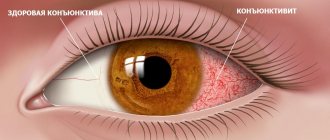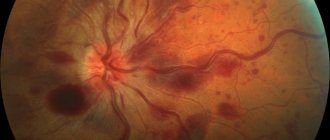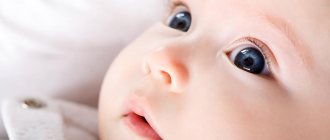Causes of strabismus in newborns
There are several reasons for physiological strabismus:
- Location of the skull bones. In newborns, the bones of the skull are mobile and soft. This is necessary for the normal passage of the baby through the birth canal. As a result, muscle tissue is located differently than in adults.
- Decreased functionality of the extraocular muscles. The baby's eyes lack normal accommodation. This is due to the fact that they did not function before childbirth. Therefore, the child gradually learns to control his eyes, to look at near and distant objects.
- Physiological farsightedness. Babies see objects that are far away. They cannot concentrate their gaze on nearby objects.
For these reasons, temporary strabismus occurs. In healthy children it should go away over time.
Causes of strabismus in children under 1 year of age
Among the causes of congenital and early strabismus are:
- infectious diseases of the mother during pregnancy;
- cerebral palsy, hydrocephalus and other disorders in the baby’s nervous system;
- genetic diseases (Down syndrome, etc.);
- intrauterine hemorrhages;
- abnormalities in the development of the organ of vision;
- compensation of congenital refractive defects;
- tumors;
- previous diseases: measles, flu with high fever, scarlet fever, rubella, etc.;
- heredity.
Why does one eye squint in a child?
With physiological strabismus, the child gradually learns to practice focusing his gaze on near and far objects. But there are times when one organ of vision in a child is more trained than the other. This leads to the fact that one eye looks straight, and the other begins to squint.
This condition can also be physiological if it occurs in the first few months of a baby’s life. If the condition is not eliminated within a period of time, it is necessary to independently train the baby’s eyes so that the strabismus does not remain in a permanent form.
How to independently determine pathology?
Determining strabismus at home is quite simple. For this you will need a flashlight. You need to carefully observe the child's eye movements. If there is a deviation, the gaze will wander, he will constantly tilt his head to the side. The child will have difficulty focusing on the subject.
If you shine a flashlight into your eyes, the reflection should be the same. Differing pictures indicate the possible presence of pathology. You should consult a doctor immediately.
Flash photography will help identify pathology. In this case, you need to take a closer look at the highlights in the baby’s eyes.
Komarovsky about childhood strabismus
Dr. Komarovsky says that normally, strabismus in a child can develop up to six months. He says this is due to decreased functionality of the extraocular muscles. This condition is now called pseudostrabismus. It is associated with the structural features of the eyeballs and the tissues around them. If after this time the strabismus does not go away, you need to consult a doctor to find the true cause of the condition.
Often, strabismus can form as a result of negative factors that affected the child in utero, due to hereditary causes, or previous infections. The most common hereditary form of strabismus occurs, which manifests itself under the influence of negative environmental factors.
Dr. Komarovsky identifies the following signs that distinguish true strabismus from physiological:
- a child over 6 months of age cannot focus both eyes on an object, one or both of them move to the side;
- lack of synchrony of the eyeballs when observing an object;
- you can use tests with a flashlight, in which one eye is completely closed, and the other may squint slightly;
- the child does not have the ability for one or both eyes to follow the toy; he needs to turn his head completely to perform this action;
- at an older age, a child may often fall and stumble, as he cannot estimate the real distance from himself to objects.
Dr. Komarovsky says that treatment begins with hardware methods and covering the healthy eye. If the conservative method does not produce results, only in this case can surgery be performed.
Types of strabismus
Depending on the underlying symptoms, experts identify up to 25 different types of the disease. Thus, strabismus in children under one year of age can be true or imaginary - and the latter is not a pathology. With imaginary - or false - strabismus, the feeling of squinting eyes appears due to the structural features of the face: close-set eyes, a wide bridge of the nose or an overdeveloped epicanthus - the fold of the upper eyelid. In addition, the cause may be the immaturity of the nerve and visual centers.
Types of strabismus
False strabismus is characteristic of an infant: it goes away on its own as it grows and facial features change, usually within the first 6 months. Strabismus of a newborn child does not require treatment. If after six months the symptoms have not disappeared, the child should be shown to an ophthalmologist to exclude or confirm true strabismus.
Primary and secondary strabismus
Depending on what disease formed the basis for the onset of the disease, strabismus can be primary or secondary.
Primary strabismus appears as a result of refractive errors - farsightedness, myopia, astigmatism. Secondary - due to pathology of eye tissue: cataracts, diseases of the fundus or vitreous body.
Friendly and unfriendly strabismus
These types of diseases differ from each other in the degree of eye mobility with pathology. If, with the friendly option, his (or theirs - if both eyes are squinted alternately) mobility in any direction is preserved, then with the unfriendly option, mobility is limited or absent. Problems with organ mobility can be caused by paresis, injuries, and abnormalities in the functioning of the extraocular muscles.
Convergent and divergent strabismus
With convergent strabismus in children (isotropy), one or both of the child’s eyes converge towards the inner corners: as if he is looking at the bridge of his nose. This is the most common type of childhood strabismus, often manifesting itself in the first year of life. With insufficient or ineffective treatment, isotropy can lead to farsightedness.
Divergent strabismus in children - exotropia - is characterized by deviation of the eyes towards the temples. Most often it occurs between 1 and 6 years of age and can lead to myopia.
Vertical and horizontal strabismus
It happens that the affected eye does not deviate towards the corners, but up or down. Such conditions are called hyper- and hypotropia. With hypertropia, parents may notice that the child seems to be trying to examine his eyebrow. The hypotropical eye, on the contrary, is directed downwards, towards the cheek.
Most often, the cause of this type of strabismus lies in the improper functioning of the extraocular muscles.
This is not a complete list of types of the disease: symptoms can appear in various combinations. In addition, there are other, rarer types of the disease that are difficult to list in one article.
Treatment
There are many methods that can be used to cure strabismus. Starting from the simplest methods, moving on to the most complex methods that can be carried out at an older age in a child.
Eye training exercises
There are several simple exercises that can be done even for a baby after 6 months. A pencil or toy is placed to the side of the affected eye. A healthy organ of vision is completely blocked. The object is gradually moved away from the child’s head, while he must concentrate his vision in order to examine it.
Covering the healthy eye
To do this, use special stickers or fabric bandages that cover the healthy eye for the whole day. Gradually, the diseased organ of vision begins to function. The child concentrates his gaze on various objects, moving his gaze from near objects to distant ones. Muscles that were not functioning begin to tense up.
This treatment does not help immediately. This requires a fairly long period of time. It may take several months or years. It all depends on the condition of the visual organs.
Gymnastics for the eyes
Many patients neglect this method, but it is quite effective. In fact, eye gymnastics allows you to train your extraocular muscles. You can practice a number of simple exercises daily, it will take no more than 5 minutes:
- turning the eyeballs clockwise and in the opposite direction;
- moving the gaze up and down, left and right;
- drawing with the eyes the numbers from 0 to 9, the infinity sign;
- tightly closing your eyes for 30 seconds;
- rapid blinking for 30 seconds;
- concentrating your gaze on the farthest object, then moving through the window to the horizon line, repeat this up to 10 times.
If the child’s strabismus is severely developed, you can repeat such training every few hours.
Hardware treatment
Specialized ophthalmic devices are used, treatment with which must be completed in courses 3-4 times a year. A person looks inside the device, an image is displayed there; for greater concentration, the doctor can highlight it. While viewing the image, the patient's healthy organ of vision is blocked, so only the affected eye is trained. The image consistently moves from the side to the center, the child tries to follow it. Therefore, the oculomotor muscles begin to function, but gradually.
Surgery
The doctor prescribes surgery if the affected eye is deviated by a large angle, there is no effect from conservative intervention, the patient does not want to wait long, he needs to get the result immediately. During the operation, the doctor cuts the extraocular muscles and, if necessary, sews them in the desired direction.
Thus, they become tense, the eye moves to its normal location.
Symptoms of strabismus
In addition to the obvious deviations, which attentive parents will definitely notice, a child with strabismus may complain of:
- diplopia (double vision). Even if the baby does not yet know how to speak, parents may notice that it is difficult for him to pick up this or that object the first time. The child experiences difficulties when drawing and active games - all because the objects on which he tries to focus his vision are double.
- decreased vision. Often with strabismus, amblyopia develops - lazy eye syndrome, in which the affected eye ceases to participate in the visual act.
- “flattening” of the perception of the surrounding world. Due to the violations, the picture does not look three-dimensional to the baby; he cannot assess the depth and distance to objects.
- discomfort in the eyes and headache after watching 3D in a cinema.
Prevention
To prevent the development of strabismus in an infant, you must adhere to the following rules:
- a healthy lifestyle for a pregnant woman, periodic visits to the necessary doctors, laboratory tests;
- if close relatives have strabismus, it is recommended to consult a geneticist;
- annual consultation with an ophthalmologist after the birth of the child;
- lack of close placement of children's toys above the crib, on which the child will concentrate attention without moving his gaze;
- toys should be located above the child’s crib at a distance of half a meter;
- ban on watching TV for up to 2 years.
Strabismus is a cosmetic defect that can be easily treated if detected in the early stages. It is recommended to fully adhere to the course of treatment prescribed by your doctor. If conservative therapy does not help, resort to surgery.
Hidden strabismus
Orthophoria, or the ideal balance of both eyes, ensured by the eye muscles, occurs in only 20% of cases, the remaining 80% are characterized by heterophoria. This occurs due to the individual anatomical structure of the eye muscles, the position of the eyeballs, and the characteristics of innervation.
It should be noted that the visual analyzer creates one common image by merging the pictures received from the two eyes separately. Therefore, the balance of the extraocular muscles is usually not disturbed, and strabismus may not be detected.
Prolonged work near the eye requires high tension in the eye muscles, which leads to deterioration of health and the appearance of migraine-like pain. Typically, the appearance of such conditions occurs in children 6–7 years old who have started school.
Since it is sometimes quite difficult to determine whether a child has strabismus or heterophoria, they must use methods that allow them to study binocular vision. With strabismus such vision is absent, but with heterophoria it is preserved.
To eliminate unwanted symptoms, it is recommended to adhere to a visual load regimen. Selection of glasses or contact vision correction is required. Special orthoptic programs are also used using synoptophore.
If the measures were unsuccessful, and the condition progressively worsens, surgery is performed to correct strabismus in children.









